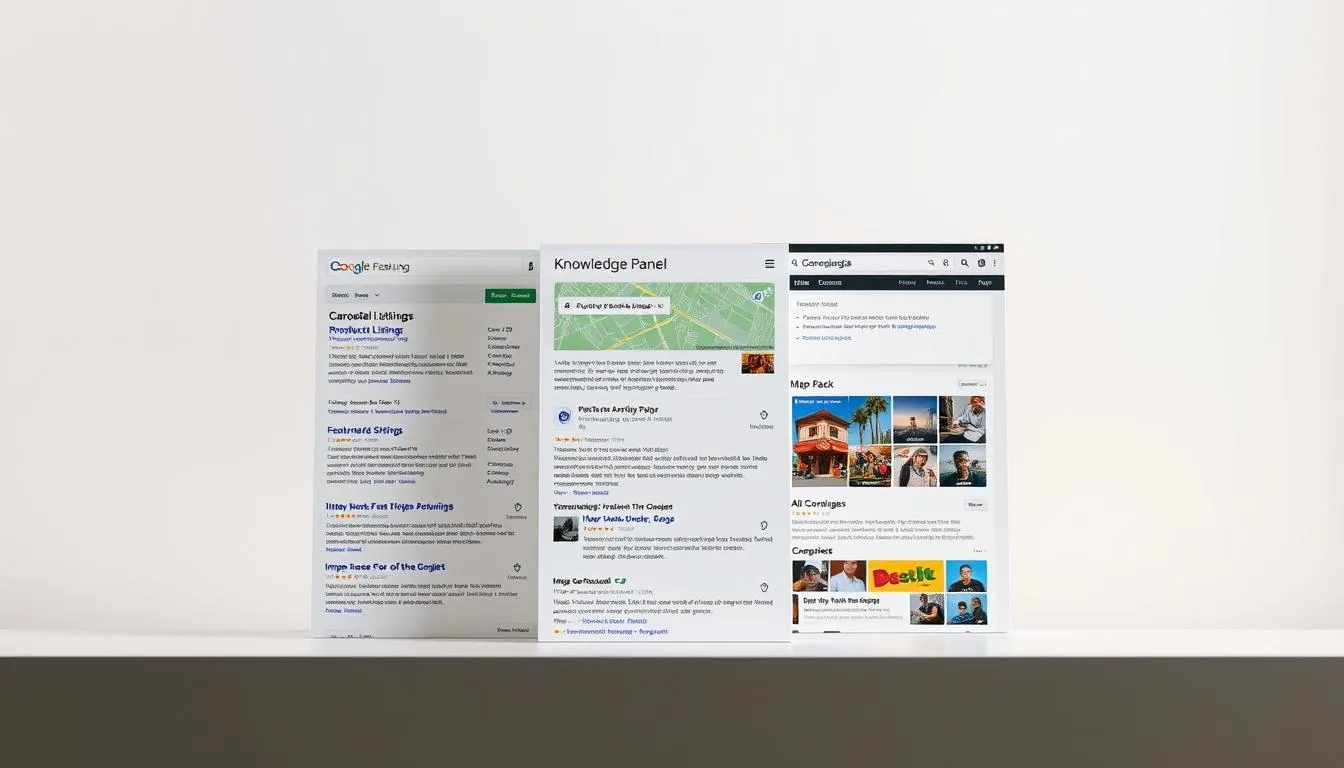Only 1.49% of Google first-page results now lack any rich elements. That means nearly every search page mixes classic listings with direct answers, media, and entity cards that shape how people find information.
The modern search engine shows Featured Snippets, Knowledge Panels, video carousels, image packs, People Also Ask, Local Pack, and Top Stories. These elements change where clicks go and how users scan a page.
This guide focuses on socialauthored SERP features like X (Twitter) cards and Top Stories alongside core results because trending posts and approved publishers can boost brand visibility during key moments.
Why this matters: the concentration of information on a single page shifts organic click-through rates and rewards content that fits each display type. With Google testing and AI Overviews falling in frequency, you must plan formats, on-page structure, and timing to earn prime placements.
Key Takeaways
- Search pages now blend links with direct answers and media that change user behavior.
- Target the right display type to win more clicks, not just higher rank.
- Socialauthored cards and Top Stories matter for trending visibility.
- Use format and structure tactics to match each result type.
- Stay agile: engine tests and AI overview changes affect outcomes.
Why SocialAuthored SERP Features Matter Right Now
Users increasingly get what they need from the results layout itself, not a website visit. Zeroclick behavior is real: roughly 46.4% of desktop and 77.2% of mobile searches end with no click. That changes how brands must compete on the page.
User intent, zeroclick behavior, and shifting real estate
Intentrich queries often get answered directly in search results, fueling zeroclick outcomes. When a Featured Snippet or a Top Stories card answers the question, organic listings lose share.
Present landscape: AI Overviews drop and the Sponsored label
AI Overviews launched in the U.S. but then dropped in frequency by about twothirds. That freed visual real estate for carousels, images, and people also ask panels.
On Oct. 14, 2024 Google changed the ad label to Sponsored. This clarity can shift perceived trust and tweak CTR between paid ads and nearby organic results.
- Fast news queries can stack Top Stories, a video carousel, and People Also Askpushing classic listings below the fold.
- Ads average ~3% CTR, while Featured Snippets capture ~8% of organic clickssmall gaps that scale into large gains or losses.
- Track presence across feature types, not just rank; format content to match where users scan for an answer.
Bottom line: the page is a competitive canvas. Use data to decide whether to target a snippet, an X card, or a news slotbecause modest CTR shifts compound quickly.
What Counts as a SERP Feature? A Friendly Primer
When someone types a search query, the engine often returns compact answers, carousels, and entity cards alongside links.
Define a serp feature as any result type that extends beyond a traditional listing by showing richer information, media, or navigation elements. These blocks aim to give users an answer fast or guide the next step.
Core result types explained
Common examples include Featured Snippets that give instant answers in text, lists, or tables.
People Also Ask surfaces follow-up questions in expandable boxes. It appears in about 8.5% of US queries.
Carousels present swipeable mediavideo carousels show up near 6% of searchesand image packs satisfy visual intent.

Entity and local surfaces
Knowledge Panels and Knowledge Cards draw from the Knowledge Graph to show entity data, not just a single website. The Local Pack focuses on proximity, reviews, and Google Business Profiles.
| Feature | Primary outcome | When it appears |
|---|---|---|
| Featured Snippet | Quick answer | Informational queries |
| People Also Ask | Explore related questions | Common follow-ups |
| Video / Image carousel | Visual preview | How-to, product, and media searches |
| Top Stories & X cards | Timely updates and real-time posts | Trending topics and news |
Mental model: map the user goalanswer, compare, explore, or transactto the result type most likely to earn the click or onpage engagement.
SocialAuthored SERP Features: The Ultimate Guide
Real-time posts and publisher feeds now shape which listings capture attention during breaking moments.
X (Twitter) cards surface for trending names and entities by showing recent posts from active or verified accounts.
- They reward posting cadence, topical relevance, and onplatform engagement like likes and replies.
- When people search a brand or leader, timely tweets can appear alongside classic results and images.
Top Stories and news carousels
Only Google Newsapproved publishers usually qualify for Top Stories. Fast workflows, clear headlines, and structured article data help coverage climb into the carousel.
Perspectives and discussiondriven results
Google is testing a Perspectives result to surface multiple viewpoints from creators and communities. This may favor voices that spark discussion and provide distinct angles.
Example workflow: publish a concise brief, share it with entity handles and hashtags, then add an explainer to capture longer interest.
Keep brand presentation consistent across web and posts so Google can link the right entity. For deeper guidance on how these result types appear, see this guide to serp features.
Mapping Search Intent to the Right Feature
Effective ranking starts by mapping each search query to the single best display on the page. That alignment increases the chance a user finds the answer fast and clicks through when needed.
Informational queries
Direct “what is” and “how to” questions often fit a featured snippet or people also ask block. Snippets work well for short definitions (4060 words), clear ordered steps, or compact tables.
People Also Ask appears in about 8.5% of US queries and is excellent for harvesting adjacent questions. Structure subheads to match those follow-up questions to improve visibility.
Fresh and trending queries
Time-sensitive queries favor X cards and Top Stories or video carousels. Publish fast updates, tag entity handles, and optimize titles to surface in news slots before interest fades.
Video results appear in roughly 6% of searches and dominate space when present, so prioritize strong thumbnails, descriptive metadata, and short-form clips when visuals aid decisions.

Local intent
Local queries map to the Map Pack. Optimize your Google Business Profile with correct categories, hours, and NAP consistency. Positive reviews and accurate citations boost prominence.
- Translate intent to feature: answer-focused queries snippet or PAA; brand lookups knowledge panels.
- Visuals: target video carousels and image packs when images help decisions.
- Playbook: assign each target query family a primary feature to win and a backup to pursue.
For a deeper checklist of how result types appear and practical steps to track presence, see this resource.
Winning Featured Snippets, PAA, and Knowledge Panels
Snippet-driven placements reward crisp answers and structured layout more than length. Aim for a direct answer near the top, then expand with helpful detail. This approach raises the odds that search will pull your content into a featured snippet or related box.
Featured snippet formats and when to target each
Match format to intent: use a 4060 word definition for straightforward queries. Pick ordered lists for step-by-step tasks. Use compact tables when users compare data.
People Also Ask: structuring answers that trigger expansions
Structure headings to mirror common questions. Put a single-paragraph answer immediately under the question-like H2 or H3. Follow with short bullets or an example to add depth and improve crawlers’ ability to expand your entry.
Knowledge Graph signals: entity consistency and sources
Reinforce entity identity across your website, author pages, and public profiles. Cite authoritative sources and use consistent naming to help the knowledge graph link facts to your brand.
- Schema markup: add Article, Organization, or Person structured data to clarify relationships.
- Internal links: point to canonical pages (about, leadership, locations) to centralize signals.
- Periodic audits: refresh phrasing to match how users ask questions today.
| Goal | Format to target | Quick tip |
|---|---|---|
| Definition or meaning | Short paragraph (4060 words) | Start with a bold, concise answer at top of page |
| How-to or process | Ordered list | Numbered steps with clear verbs and short lines |
| Compare data | Compact table | Include headers and 35 rows for clarity |
Playbook: Optimize for SocialAuthored Surfaces
To capture trending slots, teams must tune posting, newsroom speed, and onpage signals for the way results surface today.

X (Twitter) cards: cadence, topical relevance, and onSERP engagement
Post with a steady cadence tied to active topics. Use entity handles and concise copy that mirror how people search.
Encourage onSERP engagement by replying to threads, adding media, and using quote posts to show momentum. These actions help recent posts surface as X cards for brand queries.
News/Top Stories: EEAT, timeliness, and Google News best practices
News publishers should prioritize speed and clear bylines. Add unique analysis, authoritative sourcing, and structured Article schema to boost EEAT.
Keep titles tight, publish fast, and refresh recency so your coverage can appear in Top news carousels and search results.
Video and image support: thumbnails, schema, and carousel eligibility
Produce short, purposeful video clips with strong thumbnails and descriptive titles. Use Video schema and timestamps to increase carousel eligibility.
Ensure images are high quality, crawlable, and use descriptive alt text that matches the target query.
Linking strategies that reinforce entity and topic authority
Use internal links to central pages that define the entity. Point external mentions to those pages to consolidate signals.
| Tactic | Priority | Quick example |
|---|---|---|
| Posting cadence | High | 35 short updates per breaking topic |
| Article schema | High | Structured byline, publishDate, author |
| Video thumbnails | Medium | Bold title overlay + clear frame |
| Internal links | High | Link cluster canonical entity page |
Schema Markup and Structured Data for Rich Results
Clear schema gives a page machine-readable signals that unlock richer listings. Schema markup helps a search engine interpret your page content and enable enhanced results like carousels, snippets, and rich cards.
Core types to prioritize
Article is critical for news and blog content. Organization and Person markup clarify who an entity is. Use Product for e-commerce details and Video to boost media visibility. Local Business supports map presence and local results.
FAQ and Breadcrumbs: clarity for PAA and sitelinks
FAQ markup mirrors common questions so the engine can match answers to People Also Ask panels.
BreadcrumbList clarifies site structure and helps search show useful sitelinks. Both reduce friction and improve click-through for relevant queries.
How structured data supports the knowledge graph
Structured data supplies factual signals that feed the knowledge graph. Use consistent identifiers (sameAs), accurate fields, and clear relationships so the engine trusts entity facts.
- Validation: run Googles Rich Results Test and monitor Search Console for errors.
- Best practices: accurately populate required fields and avoid misleading markup.
- Governance: keep a schema library and templates to ensure uniform implementation across the website.
| Purpose | Recommended schema | Quick benefit |
|---|---|---|
| News & blogs | Article | Improves eligibility for rich snippets and Top news slots |
| Entity clarity | Organization / Person | Boosts knowledge graph linking and authoritative results |
| Ecommerce | Product | Shows price, availability, and review snippets in results |
| Media visibility | Video | Enables video carousels and enhanced playback cards |
Tip: keep your content accuratemarkup amplifies what the engine will display. Regular audits and consistent IDs help maintain trust and long-term visibility.
Measuring Impact Across SERP Features
Measure what appears on the page, not just where your URL ranks. Tracking layout changes gives a clearer view of real visibility.
Tracking visibility: rank types, universal results, and feature presence
Track by result type, not only position. Note presence in featured snippet, people also ask, video carousel, Top Stories, image packs, and local pack.
Use Search Console, rank trackers that label universal results, and analytics annotations to record when a feature appears or drops.
CTR shifts with featured snippets, ads, and video carousels
Expect CTR curves to change when a snippet or multiple ads sit above your listing. Featured snippets take about 8% of organic clicks, while ads average ~3% CTR.
Video and image results can steal attention on visual queries, even if your rank stays steady.
Zeroclick realities and engagement signals beyond the click
Zeroclick rates run high: ~46.4% desktop and 77.2% mobile. That means impressions and onpage exposure matter as much as traffic.
“Top Stories draw clicks during breaking events and favor Google Newsapproved sources.”
Blend qualitative screenshots with quantitative metrics to see how the engine lays out results over time. Then act: if ads plus a snippet suppress clicks, aim for the snippet or a visual carousel for that term.
| Metric | What to log | Why it matters |
|---|---|---|
| Feature presence | Snippet, PAA, video, Top Stories, images | Shows competing blocks that change visibility |
| CTR by layout | Clicks per layout variant | Rebenchmarks expectations when ads/snippets appear |
| Pixel depth | Abovethefold share | Measures real chance a user sees your link |
Your 90Day Action Plan for Google SERP and SocialAuthored Features
Start your 90day plan by mapping which search queries already show rich blocks and which pages lose visibility. That audit tells you where to invest time for the biggest lift.
Research: SERP audits for target search queries and result types
Weeks 12: run device-aware audits. Capture screenshots and note which query returns a snippet, video, or news slot.
Create: snippetready answers, newsworthy content, and shortform video clips
Weeks 26: draft concise answer blocks for highvolume queries. Publish timely briefs and short videos that match how users phrase a search query.
Optimize: schema markup, internal links, and entity consistency
Weeks 38: add Article, Organization, Person, Video, Product, and Local Business schema. Refine titles, meta, and internal links to central entity pages.
Evaluate: iterate with analytics, Search Console, and rank tracking
Weeks 612: track feature presence, CTR shifts, and zeroclick patterns. Use Search Console query reports to rework content and snippets.
“Featured snippets take roughly 8% of organic clicks while ads average about 3%small shifts that matter at scale.”
| Phase | Focus | Quick actions |
|---|---|---|
| Weeks 12 | Audit | Screenshot queries, tag dominant results |
| Weeks 26 | Create | Answer blocks, news briefs, short videos |
| Weeks 38 | Optimize | Schema markup, internal links, thumbnails |
| Weeks 612 | Evaluate | Track presence, adjust content, fix indexation |
Conclusion
Winning search now means engineering visibility across blocks, not just chasing a single ranking position.
Optimize for the page layout and tailor your content to the specific search results you seek. Prioritize timely posts and Top Stories slots when people want real-time updates, and aim for video thumbnails or concise answer blocks where visual cues win attention.
Reinforce entity signals with schema and consistent site metadata so the knowledge graph and engine can pick your content for high-impact results. Measure presence, pixel depth, and CTR shifts not only rank to see true visibility gains.
Zero-click contexts still deliver value when your brand owns the answer box, a people also expansion, or a visible video. Apply the 90-day plan: research, create, optimize, and evaluate iteratively to grow multi-block visibility across the serp. For a quick reference on how these blocks appear, see this guide on serp features.
FAQ
What are socialauthored SERP features and why do they matter for SEO?
Socialauthored SERP features are result types on Google that display content originating from platforms like X (Twitter), news publishers, or user discussions. They matter because they capture attention for trending queries, drive realtime visibility, and change click patterns by surfacing timely content directly on the search results page. Optimizing for these surfaces helps brands earn impressions in fastmoving search queries and supports entity authority in the knowledge graph.
How do People Also Ask and featured snippets differ in intent and format?
People Also Ask (PAA) shows related question cards that expand with concise answers, ideal for covering multiple informational angles. Featured snippets pull a single concise answerparagraph, list, or tableabove organic links to satisfy immediate intent. Target PAA when you want broad topical coverage; target featured snippets when you can deliver a precise, snippetready answer that matches the query format.
Which structured data types should I prioritize to improve visibility in rich results?
Prioritize Article, Organization, Person, Product, Video, and Local Business schema to increase eligibility for rich results. Add FAQ and Breadcrumb structured data to help Google understand page purpose and to improve sitelink and PAA chances. Proper markup supports knowledge graph signals and can make content more likely to appear in carousels, image packs, and video results.
Can posts from X (Twitter) or other platforms appear directly in Google results?
Yes. Realtime posts from X (Twitter) and publisher feeds can surface in Top Stories, news carousels, or as social cards for trending queries. Timeliness, public accessibility, and clear entity mentions increase the odds. Maintain consistent posting cadence and link back to authoritative pages to strengthen onSERP presence.
How should I map search intent to the right onSERP opportunity?
For informational intent, aim for featured snippets, PAA, and knowledge panels by providing clear definitions and structured answers. For fresh or trending queries, prioritize X cards, Top Stories, and video clips. For local intent, optimize for the map pack with Local Business schema, accurate Google Business Profile data, and local signals. Match content format to the feature users expect.
What tactics improve chances of earning a featured snippet or People Also Ask entry?
Use direct question headings, concise answers (4060 words for paragraphs), lists or tables where appropriate, and internal linking that signals topic authority. Apply structured data like FAQ and article markup, maintain entity consistency across pages, and test variations of headings and answer formats to identify which triggers the feature for your target queries.
How do knowledge panels form and how can I influence them?
Knowledge panels rely on entity data from authoritative sources, structured data, and consistent mentions across trusted sites. Provide clear Organization and Person schema, maintain accurate profiles on Wikipedia and Wikidata when applicable, and secure citations from reputable publishers. Consistency of NAP (name, address, phone) and published facts improves signals feeding the knowledge graph.
What role does schema markup play for video and image carousels?
VideoObject and ImageObject schema help search engines understand media assets, improving eligibility for video and image carousels. Include clear titles, descriptions, thumbnails, duration, and contextual text on the page. Combined with fast load times and highquality thumbnails, schema increases the chance that media will appear in universal results and drive clicks.
How should I measure the impact of universal results and zeroclick behavior?
Track feature presence and visibility using Search Console, rank trackers that report feature types, and analytics for impressions, clicks, and engagement metrics like time on page. Monitor CTR shifts when featured snippets or ads appear, and measure conversions from alternative engagement signals such as site searches, scroll depth, and social shares to capture value beyond clicks.
What does a practical 90day plan look like to win more onSERP placements?
Start with a SERP audit to identify target queries and existing feature types. Create snippetready answers, newsworthy shortform content, and social clips tied to your target keywords. Implement schema, improve internal linking and entity consistency, then measure changes with Search Console and analytics. Iterate each month based on feature presence and CTR trends.
